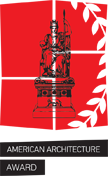

The Brick + Machine (9735 Washington) | Los Angeles - California | 2021
Architects: Abramson Architects
General Contractors: Morley Construction Company and Benchmark Contractors Inc.
Client: DLJ Capital Partners LLC., Clarett West Development LCC., and PGIM Real Estate
Photographers: Sean Costello Photography
Striking the perfect balance between historic references and contemporary elements, 9735 Washington embraces legacy architectural styles while overcoming multiple high-level design challenges. Located on what was once the site of a single-story bank building, this new state-of-the-art creative office is dubbed The Brick and Machine. Since the building did not have a named tenant during design, the architectural team explored the major drivers for attracting creative office tenants in the current commercial real estate market. As such, design decisions needed to support three main drivers: Identity, Interaction, and Connection. The site is located across from a busy triangular intersection to the South and a hospital to the North. The building footprint straddles two different city planning zones imposing a three-story limit on one side of the property and a four-story height restriction on the other.
Additionally, the location has a solar orientation that is 45% off the North. While this provides ample direct sunlight for inhabitants, careful coordination was required to mitigate the potential for excessive heat gain. The result is a unified building with two strikingly distinct identities, both deeply rooted in the past aesthetics and current ethical context of this rapidly re-developing neighborhood. The resilient office building can also sustain thermal exposure without fluctuations in heat gain thanks to a combination of passive and active energy solutions.
It's a new kind of post-pandemic workspace at the heart of a burgeoning creative technology corridor, all within a 15 minute walk of the nearest Metro station. The Brick pays homage to the surrounding historic core, essentially a contemporary interpretation of the historic landmarks in the Culver City area. Bricks are used as an ornamental tile and again to create a 3D pattern that emulates ivy growth and provides variation and shadow play. This textured half of the project features a dynamic shift between large, building-scale window openings to a finely hewn, human-scale materiality.
The Machine features a series of small-scale exterior balconies equipped with operable full-height screens made from perforated aluminum. The punched metal panels offer visual privacy for the inset balconies while also providing cross ventilation through the building and into the central courtyard. The large, rolling metal panels span both the facade of the building and the open-air balconies, allowing their daily movements to add to the vitality of Downtown Culver City. The two distinct office environments are connected at the main entrance storefront through a large-scale public art installation by glass artist Veronika Kellndorfer. Once inside, The Brick and Machine share expansive landscaped areas including a multi-story courtyard and an activated rooftop deck.
The central courtyard that connects the two environments brings natural light into the depth of the building. It also connects the different building volumes and levels with bridges and an external stair. The central courtyard provides protected private exterior space at a medium scale for small teams and group meetings and doubles as a light well bringing in natural light from the center of the building. The Brick building's fourth floor becomes the backdrop for unexpected outdoor experiences, such as panoramic 'golden hour' views during happy hour. Strategically placed planters aid in rainwater collection while instilling a meadow-like quality to the roof deck. The perimeter landscape creates the impression of walking within an elevated garden and a series of additional planter boxes help break the garden's overall massing into various scales of human-centric outdoor spaces.